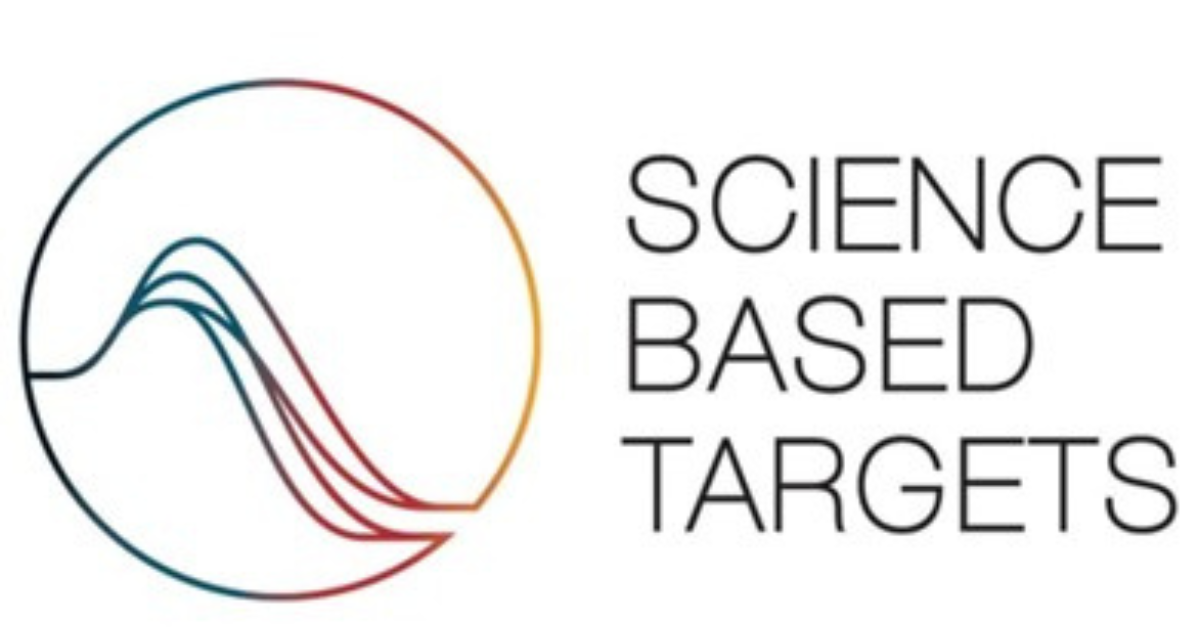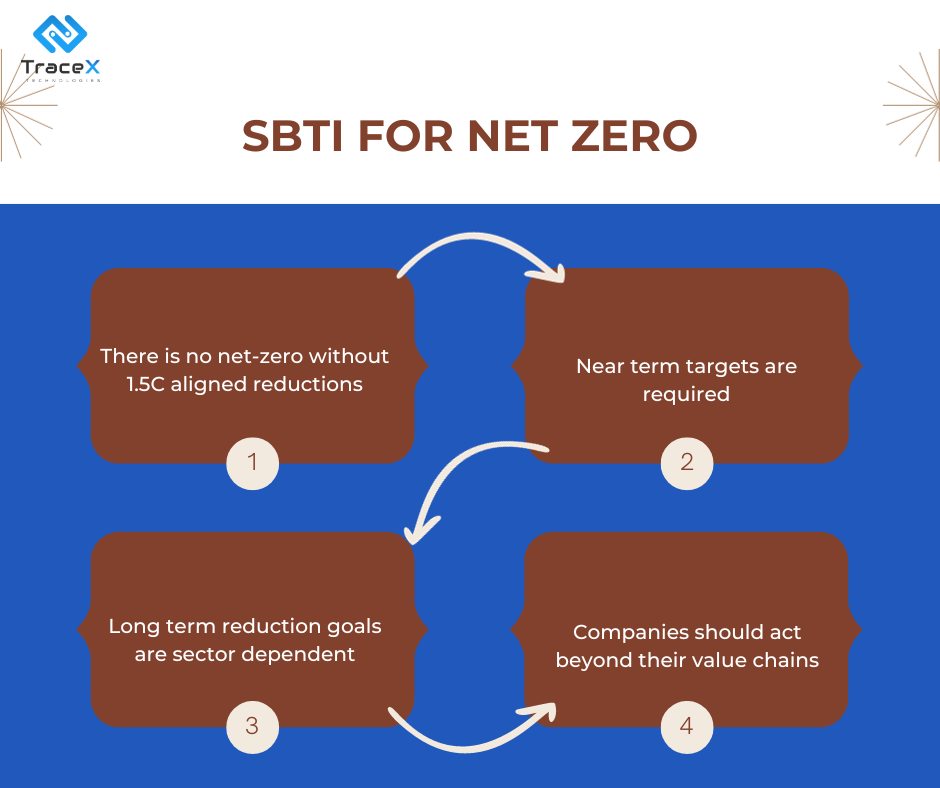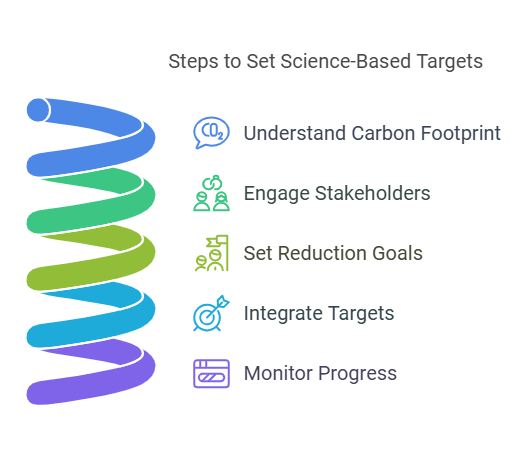Contact: +91 99725 24322 |
Menu
Menu
Quick summary: Discover how the Science-Based Targets Initiative (SBTi) helps businesses set credible emissions reduction goals aligned with the Paris Agreement, ensuring a sustainable future and compliance with global climate targets.

Is your business ready to meet the challenges of climate change head-on? The Science-Based Targets Initiative (SBTi) is empowering companies worldwide to take meaningful action by setting emissions reduction goals aligned with the latest climate science. But here’s the catch: many businesses still struggle to understand how to integrate science-based targets into their operations effectively, often falling behind on crucial sustainability commitments.
Companies must set long-term science-based targets that align to 1.5°C for a target year no later than 2050 as part of their net-zero commitment. These targets cover a minimum of 95%of scope 1 & 2 emissions, and 90%of scope 3 emissions.
Without a clear framework, it can be tough to ensure your goals are not only ambitious but also achievable and aligned with global climate targets. This is where the Science-Based Targets Initiative (SBTi) comes in, providing businesses with the structure needed to reduce emissions and stay competitive in a world increasingly focused on sustainability. Let’s dive deeper into how the SBTi can help you create a roadmap for a climate-resilient future.
Key Takeaways
The Science-Based Targets Initiative (SBTi) is a global movement helping businesses set credible, science-driven targets to reduce their carbon emissions. Its main aim is to align corporate efforts with the latest climate science, ensuring that companies contribute to limiting global warming to well below 2°C, with efforts to keep it to 1.5°C, as per the Paris Agreement.
SBTi helps businesses take meaningful action on climate change by offering a framework for setting ambitious, yet achievable emissions reduction goals. The initiative uses the most up-to-date climate science to guide companies in reducing their greenhouse gas emissions at a pace that’s consistent with global efforts to combat climate change.
The Paris Agreement is a global treaty aimed at reducing greenhouse gas emissions to limit global temperature rise to below 2°C, with the goal of reaching 1.5°C. The SBTi directly aligns with this by ensuring that corporate emissions reduction targets are in line with this critical international goal, helping businesses take part in the global fight against climate change.
The SBTi was launched in 2015 by a collaboration of leading organizations, including the World Resources Institute (WRI), the Carbon Disclosure Project (CDP), the United Nations Global Compact, and the World Wide Fund for Nature (WWF). Since its inception, the initiative has grown significantly, with thousands of companies globally now setting science-based targets. The growing importance of the SBTi is evident in its increasing adoption, as businesses recognize the need to act in line with both scientific consensus and regulatory pressures around climate action.
In today’s world, customers, investors, and governments expect businesses to take responsibility for their environmental impact. By setting science-based targets through the SBTi, companies are not only helping to meet international climate goals but also positioning themselves as leaders in sustainability—building trust with customers, investors, and stakeholders. It’s not just about compliance; it’s about future-proofing your business for a sustainable tomorrow.
When businesses set sustainability goals, it’s easy to fall into the trap of aiming for arbitrary targets that may not drive real change. That’s where science-based targets come in—these are targets rooted in the latest climate science, specifically designed to limit global warming to no more than 1.5°C or 2°C above pre-industrial levels. But how are these targets determined, and why do they matter so much?

SBTi targets are not random numbers; they are built using climate models and cutting-edge scientific data that show how much we can emit while still staying within the globally agreed-upon limits. The SBTi uses climate science and projections of emissions reductions needed to avoid the worst impacts of climate change, giving companies a solid, science-backed framework to follow.
You may have heard of the 1.5°C and 2°C targets—these are not just numbers, but critical thresholds. According to the Intergovernmental Panel on Climate Change (IPCC), limiting global warming to 1.5°C can help reduce the most severe impacts of climate change, such as extreme weather events and rising sea levels. If we hit 2°C, the risks become even greater. So, when businesses align their targets with these limits, they’re helping avoid the worst-case scenarios for our planet.
Not all industries are the same, and that’s why SBTi also tailors emissions reduction targets based on sector-specific guidelines. These guidelines ensure that the targets are achievable yet ambitious enough to drive real impact. Whether you’re in agriculture, manufacturing, or tech, SBTi ensures that businesses get the right guidance on how much and how fast to reduce emissions based on their specific sector, resources, and challenges.
By using science-based targets, businesses ensure they’re not only contributing to climate action but are also taking steps that are aligned with real scientific data, setting themselves up for long-term sustainability.
In today’s rapidly changing business landscape, sustainability is no longer a nice-to-have—it’s a must-have. The Science-Based Targets Initiative (SBTi) is essential for businesses looking to stay competitive, comply with growing regulations, and build long-term value.
Businesses today are under increasing pressure to meet international climate commitments. With regulations tightening and climate action gaining momentum worldwide, aligning with the SBTi helps your business stay ahead of the curve. By adopting science-based targets, you ensure your emissions reduction goals are in line with the latest climate science, minimizing regulatory risks and positioning your company as a responsible, future-ready entity.
Consumers are becoming more conscious of the environmental impact of the products and services they buy. By committing to science-based targets, you boost your brand’s credibility as a sustainability leader. This not only strengthens your reputation but also builds consumer trust. Businesses that showcase their climate commitments through the SBTi stand out as trustworthy, environmentally-conscious brands that resonate with today’s eco-aware customers.
Sustainability is often seen as an expense, but in reality, it can drive significant savings. By setting science-based targets, businesses are encouraged to focus on operational efficiency, energy savings, and renewable practices. Whether it’s cutting down on energy consumption, optimizing resource use, or reducing waste, these practices often lead to lower operational costs while simultaneously reducing your carbon footprint.
Investors, consumers, and regulators are all demanding more from businesses when it comes to climate action. The global demand for climate-conscious companies is skyrocketing. By aligning with SBTi’s science-based targets, you demonstrate your commitment to sustainability, which can attract investment, increase customer loyalty, and ensure your business is in line with future regulatory requirements. Climate-conscious businesses are not just seen as ethical—they’re also seen as forward-thinking and adaptable to the future.

When it comes to setting science-based emissions reduction targets, a one-size-fits-all approach simply doesn’t work. Every industry has its unique challenges, operations, and environmental impacts, which is why the Science-Based Targets Initiative (SBTi) provides tailored guidelines for different sectors like agribusiness, manufacturing, energy, and retail. These sector-specific guidelines help businesses in each industry set targets that are not only achievable but also impactful in their particular context.
The beauty of industry-specific SBTi guidelines is that they take into account the unique characteristics of each sector. For example, an agribusiness company might face different challenges around emissions than a retail business or a manufacturing plant. By using tailored guidelines, companies ensure that their goals are realistic and aligned with the climate science relevant to their sector, making the targets more impactful and meaningful.
Each industry has varying levels of carbon intensity, resource use, and emission reduction opportunities. For instance, while renewable energy might be a top priority for the energy sector, waste reduction and energy efficiency could play a more significant role in manufacturing or retail. These guidelines allow businesses to focus on the areas where they can make the most difference, while staying within the boundaries of science-backed climate goals.
Agribusinesses are a critical part of global emissions, but they also have a unique opportunity to lead the charge in sustainability. With the SBTi’s agribusiness guidelines, companies in this sector can set emissions reduction goals that reflect the challenges and opportunities within agriculture.
For example, companies can focus on sustainable farming practices, reducing methane emissions from livestock, or improving the efficiency of food production and distribution. One notable example is a large agribusiness that implemented regenerative agricultural practices to meet their science-based targets, improving soil health and reducing emissions while also increasing productivity.
Manufacturers often face significant emissions from energy consumption, transportation, and industrial processes. With SBTi’s specific guidelines for manufacturing, businesses can focus on energy efficiency improvements, shifting to renewable energy, and reducing waste throughout their supply chains.
A major automotive manufacturer adopted the SBTi framework to reduce their carbon footprint across their global supply chain by focusing on more efficient production practices and a switch to electric vehicles, significantly cutting their emissions while staying competitive in the industry.
In the energy sector, SBTi guidelines focus on reducing emissions from fossil fuel use and transitioning to renewable energy sources. The guidelines encourage companies to set aggressive targets for transitioning their energy mix to cleaner sources and investing in carbon capture technologies.
For instance, a leading global energy company adopted SBTi’s guidance to transition towards a low-carbon energy future, prioritizing the development of wind and solar energy infrastructure to meet their emissions reduction goals, and showcasing their commitment to the global shift to renewables.
Retailers have a significant impact on emissions due to transportation, packaging, and supply chain logistics. SBTi’s guidelines for the retail sector emphasize reducing emissions through energy-efficient operations, sustainable packaging, and optimizing supply chains. A major global retailer adopted these targets and shifted toward using sustainable materials, optimizing their distribution networks, and offering carbon-neutral product lines, significantly reducing their carbon footprint while attracting eco-conscious customers.
Tailored guidelines for each industry make the SBTi framework accessible, practical, and effective. By focusing on the specific challenges and opportunities in their respective sectors, businesses can:
Whether you’re in agribusiness, manufacturing, energy, or retail, the SBTi provides a tailored roadmap to help your business reduce emissions, comply with regulations, and stay ahead of the curve in the race to combat climate change. By adopting these science-based targets, your business is not only aligning with climate science but also setting itself up for long-term success in a carbon-conscious world.
Setting science-based targets (SBTi) is a powerful way for businesses to align with global climate goals, but the journey is not without its challenges. Many businesses face common obstacles when implementing SBTi targets, such as gathering accurate data, integrating sustainability goals into existing operations, and aligning internal stakeholders. However, these challenges aren’t insurmountable. With the right tools, strategies, and expert guidance, businesses can overcome these hurdles and make significant progress toward achieving their sustainability targets.
One of the biggest hurdles businesses face is collecting accurate and comprehensive data. To set science-based targets, companies need detailed information about their carbon emissions across various departments, processes, and supply chains. Gathering this data can be time-consuming and complex, especially for large organizations with global operations. Without reliable data, it’s difficult to set credible targets or track progress effectively.
Businesses often struggle with integrating sustainability targets into their day-to-day operations. This challenge arises because sustainability practices require coordination across different functions— from procurement to manufacturing to distribution— which can be difficult to manage with existing processes and systems. In many cases, sustainability goals may also conflict with short-term business priorities, making it harder to prioritize them at an organizational level.
Implementing SBTi targets involves aligning various stakeholders within the business, including senior leadership, departments, and even supply chain partners. This alignment can be tricky because not everyone may fully understand the importance of these targets or how they contribute to the company’s overall success. Resistance to change or a lack of understanding about the long-term benefits of sustainability may lead to slow adoption across the organization.
One of the strengths of the SBTi is its ability to break down complex sustainability goals into actionable, achievable milestones. The SBTi provides a structured approach to setting emissions reduction targets that are both science-based and tailored to each sector. By following these guidelines, businesses can develop clear, measurable steps toward their targets, making the process feel less overwhelming.
The SBTi’s approach ensures that businesses set targets that are both ambitious and feasible, with specific timelines and benchmarks. This makes it easier for companies to track their progress, celebrate small wins, and continuously adjust their strategies as needed. By breaking down larger goals into manageable steps, the SBTi helps businesses stay focused and motivated on their sustainability journey.
As businesses work to meet their science-based targets (SBTi), technology is becoming an essential ally. Achieving these ambitious emissions reduction goals requires more than just commitment—it needs accurate tracking, efficient reporting, and reliable verification. This is where digital solutions like TraceX’s blockchain-based DMRV platforms come into play, helping companies streamline their sustainability initiatives and ensure compliance with SBTi guidelines.
Tracking emissions accurately is the first step in meeting SBTi targets. But manually gathering data across a global supply chain can be time-consuming and error-prone. This is where advanced digital solutions like TraceX’s blockchain-based platforms come in. These platforms enable businesses to automatically track emissions in real-time, ensuring that every step in the supply chain is accounted for.
With blockchain technology, businesses can securely store and verify emissions data, ensuring transparency and accountability. By creating a decentralized, immutable record of data, blockchain ensures that the reported emissions are accurate and tamper-proof. This helps businesses build trust with stakeholders, from investors to consumers, as they work toward their sustainability goals.
One of the biggest challenges businesses face in achieving SBTi targets is keeping up with the constantly changing emissions landscape. With regulations evolving and climate science becoming more refined, staying on top of emissions data is crucial. Technology makes this easier by providing real-time data tracking, allowing businesses to monitor their carbon footprint as it happens, rather than waiting until the end of the reporting period.
Automated reporting is another key benefit of using technology. Instead of manually compiling emissions data and generating reports, digital tools can automate the process, saving businesses time and reducing the risk of human error. With automated reporting, businesses can quickly generate the necessary reports to demonstrate their progress towards their science-based targets. This helps streamline SBTi compliance and ensures that businesses are always ready for audits or inspections.
Achieving SBTi targets is not just about tracking emissions; it’s about creating a comprehensive sustainability strategy. Technology plays a vital role in simplifying this process. Tools like TraceX’s platform provide a centralized hub for all sustainability data, making it easier to align your emissions reduction goals with your overall business strategy.
By integrating these digital solutions into everyday operations, businesses can ensure that their sustainability initiatives are coordinated, accurate, and impactful. These platforms provide businesses with actionable insights into their emissions, allowing them to identify areas for improvement, optimize energy usage, and reduce waste. In addition to improving accuracy, this streamlined approach helps businesses save costs and improve efficiency.
The Science-Based Targets Initiative (SBTi) offers businesses a clear and credible path to align with global climate goals, especially the critical target of limiting global warming to 1.5°C. By setting science-driven emissions reduction targets, businesses not only contribute to the global effort against climate change but also position themselves as leaders in sustainability. Adopting SBTi targets helps mitigate risks, build trust with consumers, and improve operational efficiency. As the world faces pressing climate challenges, businesses that embrace SBTi’s rigorous framework will be equipped to thrive in a future that demands sustainable practices.
Science-Based Targets (SBTi) are emissions reduction goals that are aligned with the latest climate science, specifically aiming to limit global warming to 1.5°C or 2°C. These targets help businesses set realistic and measurable goals to reduce their carbon footprint in line with global climate goals.
Adopting SBTi targets helps businesses stay ahead of regulatory changes, reduces operational costs, and builds stronger consumer trust. It also ensures that companies are part of the solution in fighting climate change by contributing to the global effort to limit warming to 1.5°C.
SBTi targets drive sustainable growth by ensuring that companies focus on efficient practices, renewable energy, and emissions reduction strategies. They not only meet climate goals but also enhance brand reputation and unlock new opportunities with investors and stakeholders focused on sustainability.
